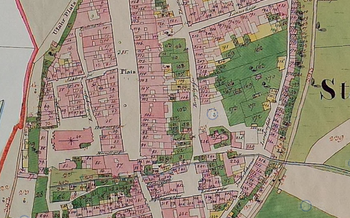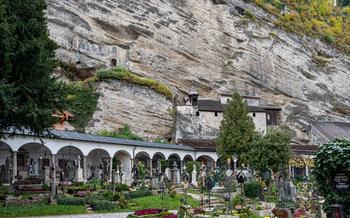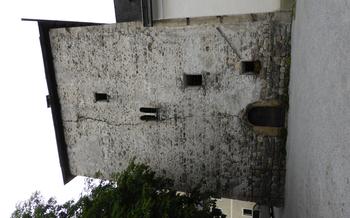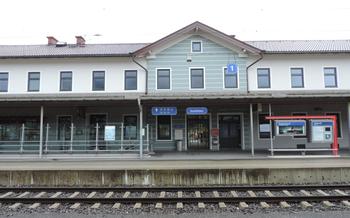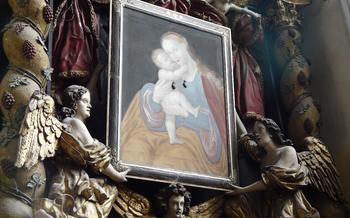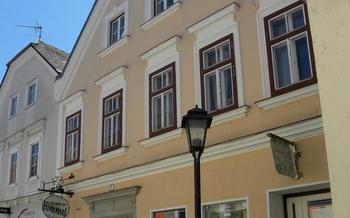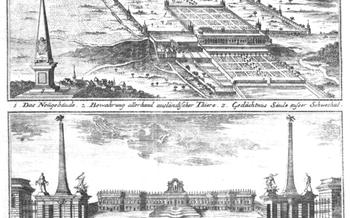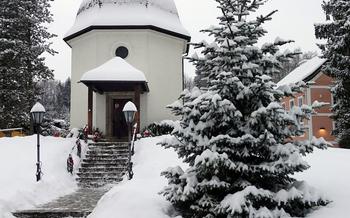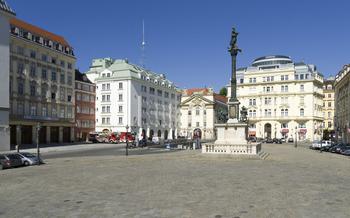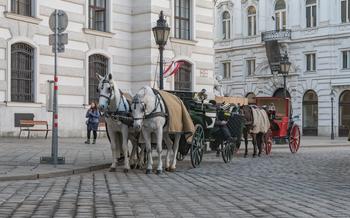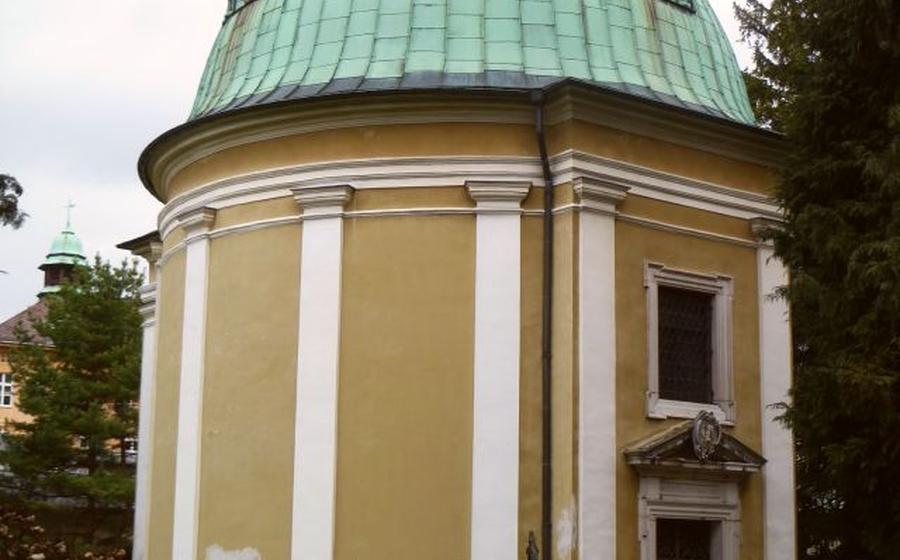
St. Sebastian's Cemetery
- St. Sebastian's Cemetery: A Historical Overview
- Exploring the Cemetery's Unique Architecture
- Famous Graves and Monuments
- The Catacombs: A Hidden Gem
- Memorial Chapel (Gedächtniskapelle)
- Kapelle St. Sebastian
- Visiting Information
- Respecting the Deceased
- Photography and Videography
- Local Traditions and Customs
- Nearby Attractions: Expanding Your Salzburg Experience
- Personal Reflections: A Walk Through History
- Cultural Significance: Art, Music, and Literature
- Conservation Efforts: Preserving the Legacy
- Insider Tip: Unveiling Hidden Stories
St. Sebastian's Cemetery: A Historical Overview
St. Sebastian's Cemetery, nestled in the heart of Salzburg, Austria, is a treasure trove of history and culture. Its origins can be traced back to the Middle Ages, when it served as a burial ground for the city's residents. Over the centuries, the cemetery has undergone several expansions and renovations, reflecting the changing needs and tastes of the time.
In the 17th century, the cemetery underwent a significant transformation under the influence of the Baroque era. Elaborate tombstones, adorned with intricate carvings and sculptures, began to appear, showcasing the artistic prowess of the period. Notable among these is the tomb of Johann Michael Haydn, the younger brother of the renowned composer Joseph Haydn.
The 19th century brought about a shift towards Gothic Revival architecture, characterized by pointed arches, ribbed vaults, and intricate tracery. This style is exemplified by the Memorial Chapel, built in 1878, which serves as a poignant tribute to the deceased.
St. Sebastian's Cemetery is not only a resting place for the departed but also a repository of Salzburg's rich history. It bears witness to the city's cultural, artistic, and social evolution, making it a captivating destination for visitors seeking an authentic glimpse into the past.
Exploring the Cemetery's Unique Architecture
The St. Sebastian's Cemetery is a masterpiece of architectural design, blending Baroque and Gothic influences to create a visually stunning and symbolic space. The cemetery's layout is characterized by its symmetrical design, with rows of graves arranged in a grid-like pattern. The graves are adorned with intricate carvings and sculptures, reflecting the Baroque style's emphasis on ornamentation and grandeur.
Gothic elements are also evident in the cemetery's architecture. The pointed arches, ribbed vaults, and flying buttresses of the Memorial Chapel and the Kapelle St. Sebastian are reminiscent of Gothic cathedrals. These architectural features create a sense of height and drama, emphasizing the spiritual significance of the cemetery.
The symbolism in the cemetery's architecture is profound and thought-provoking. The use of skulls and crossbones, for example, serves as a reminder of mortality and the transience of life. Angels and cherubs represent the hope of resurrection and eternal life. The weeping willows and cypress trees symbolize grief and mourning.
Every element of the St. Sebastian's Cemetery's architecture has been carefully considered to create a harmonious and meaningful space that invites contemplation and reflection. The cemetery is a testament to the skill and artistry of the architects and craftsmen who designed and built it.
Famous Graves and Monuments
St. Sebastian's Cemetery is the final resting place of some of Austria's most renowned figures, attracting visitors from around the world who come to pay their respects and learn about the lives and legacies of these iconic individuals.
Wolfgang Amadeus Mozart: The towering genius of classical music found his final resting place in St. Sebastian's Cemetery. Although his exact grave location remains uncertain, a cenotaph erected in his honor marks the significance of his presence within the cemetery's hallowed grounds. Mozart's music continues to captivate audiences worldwide, and his grave serves as a pilgrimage site for music lovers seeking to connect with the master's eternal legacy.
Joseph Mohr: The lyricist of the beloved Christmas carol "Silent Night," Joseph Mohr, is also laid to rest in St. Sebastian's Cemetery. His grave, adorned with a simple cross and epitaph, stands as a testament to the enduring power of his words, which have brought comfort and joy to countless hearts during the holiday season.
Franz Xaver Gruber: The composer of the music for "Silent Night," Franz Xaver Gruber, lies buried near Joseph Mohr, further solidifying the cemetery's connection to this iconic carol. Gruber's grave serves as a reminder of the collaborative spirit that gave birth to one of the world's most cherished Christmas songs.
Beyond these musical giants, St. Sebastian's Cemetery is home to the graves of numerous other notable artists, composers, and personalities who have shaped Salzburg's rich cultural heritage. Among them are the renowned painter Hans Makart, the talented sculptor Ludwig Schwanthaler, and the esteemed architect Kajetan Oberhauser. Each grave tells a unique story, offering visitors a glimpse into the lives and contributions of these remarkable individuals who left an indelible mark on Salzburg's artistic and cultural landscape.
The Catacombs: A Hidden Gem
Beneath the surface of St. Sebastian's Cemetery lies a hidden treasure—the catacombs. These subterranean chambers, once used for religious ceremonies and burials, offer a glimpse into the past and provide a unique perspective on Salzburg's history.
The catacombs were constructed in the 17th century as an extension of the cemetery, providing additional burial space during a time of high mortality. They consist of a network of narrow tunnels and chambers, lined with niches where the deceased were laid to rest.
In the 19th century, the catacombs were closed to new burials and fell into disuse. Over time, they became forgotten and hidden from public view. It was not until the late 20th century that the catacombs were rediscovered and restored, revealing a fascinating glimpse into the past.
Today, visitors can explore the catacombs on guided tours, which offer a unique and eerie experience. The tours provide insights into the history of the catacombs, the people who were buried there, and the funerary practices of the time.
As you wander through the dimly lit tunnels, you can see the remains of hundreds of individuals, some of whom have been buried for centuries. The walls are lined with skulls and bones, arranged in intricate patterns and adorned with religious symbols.
The catacombs are a reminder of the fragility of life and the inevitability of death. They offer a glimpse into the past and provide a unique perspective on the history of Salzburg.
Memorial Chapel (Gedächtniskapelle)
The Memorial Chapel (Gedächtniskapelle) stands as a poignant testament to the lives and legacies of those laid to rest in St. Sebastian's Cemetery. Constructed in 1595, this exquisite chapel exudes a serene and contemplative atmosphere, inviting visitors to pause and reflect on the transience of life.
The chapel's architectural design showcases a harmonious blend of Gothic and Renaissance elements, featuring intricate stone carvings and delicate stained glass windows. Step inside to discover a rich tapestry of artwork and symbolism that adorns the walls and ceiling. Murals depicting scenes from the life of Christ, along with sculptures of angels and saints, create a sense of divine presence and eternal hope.
One of the most striking features of the chapel is the altar, which serves as a focal point for contemplation and prayer. Intricately carved with scenes from the Passion of Christ, the altar serves as a reminder of the sacrifice and resurrection that lies at the heart of the Christian faith.
The Memorial Chapel is not only a place of remembrance but also a symbol of the enduring spirit of Salzburg's artistic and cultural heritage. It stands as a reminder of the deep-rooted traditions and beliefs that have shaped the city's identity throughout the centuries.
Kapelle St. Sebastian
Adjacent to the St. Sebastian's Cemetery, the Kapelle St. Sebastian stands as a poignant testament to the life and martyrdom of Saint Sebastian. Erected in 1504, the chapel exudes an aura of sanctity and reverence. Its intricate Gothic architecture, with its pointed arches and delicate tracery, transports visitors back in time.
The Kapelle St. Sebastian holds a significant place in the history of the cemetery. It was here that the remains of Saint Sebastian, a Roman soldier martyred for his Christian faith, were initially interred. The chapel served as a pilgrimage site for centuries, attracting devout believers seeking solace and inspiration.
Beyond its religious significance, the Kapelle St. Sebastian is a treasure trove of artistic and cultural heritage. The chapel's interior is adorned with exquisite frescoes depicting scenes from the life of Saint Sebastian, rendered in vibrant colors and intricate detail. These murals, created by talented artists of the Renaissance era, offer a glimpse into the artistic sensibilities of the time.
The legend of Saint Sebastian is inextricably linked to the Kapelle St. Sebastian and the cemetery. According to tradition, Saint Sebastian appeared to a gravedigger in a dream, instructing him to build a chapel on the site. This divine revelation led to the construction of the Kapelle St. Sebastian, which has since become a sacred space for contemplation and remembrance.
Visiting Information
Opening Hours and Admission Fees: St. Sebastian's Cemetery is open to the public daily, with varying hours depending on the season. During the summer months (April to October), the cemetery is generally open from 8:00 am to 6:00 pm, while in the winter months (November to March), the hours are typically from 9:00 am to 5:00 pm. Admission to the cemetery is free of charge, allowing visitors to explore the grounds and pay their respects without any financial barriers.
Guided Tours: For those seeking a deeper understanding of the cemetery's history and significance, guided tours are available. These tours are conducted by knowledgeable guides who provide insights into the lives and legacies of the notable figures buried within the grounds. Guided tours typically cover the cemetery's history, famous graves, and architectural highlights, offering a comprehensive exploration of this sacred space.
Accessibility and Facilities: St. Sebastian's Cemetery is wheelchair accessible, ensuring that visitors of all abilities can comfortably navigate the grounds. The cemetery also features restrooms and water fountains for the convenience of visitors, making it a welcoming and accessible destination for all.
Respecting the Deceased
When visiting St. Sebastian's Cemetery, it is essential to maintain proper etiquette and behavior out of respect for the deceased and their families. The serene and sacred nature of the grounds should be upheld by all visitors.
While exploring the cemetery, avoid making excessive noise or engaging in disruptive activities that may disturb the peace and tranquility of the environment. Be mindful of your surroundings and refrain from talking loudly or laughing boisterously.
It is important to respect the privacy of the deceased and their families by not intruding on personal spaces or memorials. Do not touch or lean on tombstones or other funerary structures without permission.
When taking photographs or videos, ensure that you are not disturbing other visitors or capturing images of mourners without their consent. Always ask for permission before photographing or filming individuals or specific gravesites.
Remember that the cemetery is an active burial ground, and funerals or memorial services may be taking place during your visit. Be respectful of these events by maintaining a quiet and solemn demeanor.
By adhering to these guidelines, visitors can help preserve the sanctity of St. Sebastian's Cemetery and ensure that it remains a place of peace and remembrance for all.
Photography and Videography
Respecting the Deceased and Preserving the Sanctity of the Grounds
Documenting your visit to St. Sebastian's Cemetery through photography or videography is a wonderful way to capture the beauty and significance of this hallowed ground. However, it's essential to maintain a respectful demeanor and adhere to specific guidelines to ensure you don't disturb the peace or disrespect the deceased and their families.
Guidelines for Photography and Videography:
Prioritize Respect: - Seek permission from cemetery staff or officials before taking any photos or videos, especially if you plan to use them for commercial purposes.
Avoid Intrusion: - Refrain from taking photos or videos of individuals visiting graves or showing signs of grief. Respect their privacy and allow them to grieve in peace.
Focus on Details: - Capture the architectural elements, sculptures, and inscriptions that make the cemetery unique. Focus on the artistic and historical aspects rather than individuals.
Use Discretion: - Be aware of your surroundings and avoid taking photos that might be considered inappropriate or disrespectful.
No Flash Photography: - Flash photography is strictly prohibited. It can be disruptive and disrespectful to visitors and may damage sensitive artifacts.
Tripods and Equipment: - Use tripods and other equipment discreetly. Ensure they don't obstruct walkways or disturb other visitors.
Remain Silent: - Maintain a respectful silence while taking photos or videos. Avoid loud conversations or disruptive behavior.
By following these guidelines, you can ensure that your documentation of St. Sebastian's Cemetery is done in a respectful and considerate manner, preserving the sanctity of this historic site for generations to come.
Local Traditions and Customs
The St. Sebastian's Cemetery is not just a resting place for the deceased but also a site deeply embedded in local traditions and customs. One unique tradition associated with the cemetery is the annual All Souls' Day procession, held on November 2nd. During this procession, locals gather at the cemetery to honor and remember their departed loved ones. They carry lanterns and candles, creating a solemn and atmospheric procession through the cemetery grounds.
Austrian funeral customs and rituals also play a significant role in shaping the cemetery's atmosphere. Funerals in Austria are typically somber and respectful, with a focus on honoring the deceased and providing support to their family and friends. The graves are often decorated with flowers, candles, and personal mementos, reflecting the deep emotional attachment that Austrians have with their deceased loved ones.
Understanding these local traditions and customs can enhance your visit to the St. Sebastian's Cemetery, providing a glimpse into the rich cultural heritage of Salzburg and Austria.
Nearby Attractions: Expanding Your Salzburg Experience
St. Sebastian's Cemetery is situated in the heart of Salzburg, surrounded by a wealth of cultural and historical attractions that enhance your visit to this vibrant city. A short stroll from the cemetery, you'll find the Mirabell Palace and Gardens, a stunning Baroque masterpiece with manicured gardens and intriguing sculptures. Take a leisurely walk through the palace grounds, admiring the intricate fountains and flower beds, before stepping inside to explore its opulent halls and staterooms.
For art enthusiasts, the Museum of Modern Art Salzburg is a must-visit. Located just a few minutes away from the cemetery, this contemporary art museum showcases a diverse collection of works by renowned local and international artists. Admire thought-provoking paintings, sculptures, and installations that challenge conventional notions of art and creativity.
The Salzburg Cathedral, a magnificent symbol of religious devotion, is another nearby attraction that deserves your attention. Its towering spires dominate the city's skyline, inviting you to explore its rich history and awe-inspiring architecture. Step inside to marvel at the intricate carvings, stained glass windows, and opulent furnishings that adorn this sacred space.
To delve deeper into the musical legacy of Salzburg, visit the Mozart Geburtshaus, the birthplace of the legendary composer Wolfgang Amadeus Mozart. Discover the rooms where Mozart spent his early years, now transformed into a museum dedicated to his life and work. Listen to his enchanting compositions, admire his personal belongings, and gain insights into the genius that shaped the world of classical music.
By combining your visit to St. Sebastian's Cemetery with these nearby attractions, you'll create a comprehensive and enriching itinerary that captures the essence of Salzburg's cultural heritage.
Personal Reflections: A Walk Through History
My visit to St. Sebastian's Cemetery was a profound and moving experience. As I wandered among the ancient headstones and gazed upon the elaborate mausoleums, I felt a deep sense of history and connection to the past. The cemetery's serene atmosphere invited contemplation and reflection, allowing me to ponder the lives and legacies of those who had been laid to rest within its hallowed grounds.
Each grave I encountered told a unique story, offering glimpses into the lives and times of Salzburg's former inhabitants. From the grand monuments of famous composers to the humble graves of ordinary citizens, every tombstone bore witness to the city's rich and storied past. The weathered inscriptions and faded photographs spoke of love, loss, and the enduring human spirit.
As I strolled through the cemetery, I couldn't help but be struck by the beauty and artistry of the surroundings. The intricate carvings, delicate sculptures, and vibrant colors reflected the Baroque and Gothic influences that shaped Salzburg's architectural heritage. Every detail, from the cherubs and angels adorning the tombs to the ornate wrought-iron gates, seemed to whisper secrets of a bygone era.
My visit to St. Sebastian's Cemetery was a transformative experience that left an indelible mark on my soul. It was a journey through time, a meditation on life and death, and a celebration of the human spirit. The cemetery's unique atmosphere and poignant beauty reminded me of the interconnectedness of all things and the enduring power of memory.
Cultural Significance: Art, Music, and Literature
St. Sebastian's Cemetery has served as a rich source of inspiration for artists, musicians, and writers throughout history. Its unique atmosphere and the presence of notable figures buried within its walls have captivated creative minds for centuries.
One of the most famous examples is Wolfgang Amadeus Mozart, whose final resting place in the cemetery has attracted countless visitors seeking to pay homage to the musical genius. His grave, often adorned with fresh flowers and mementos, has become a pilgrimage site for music lovers worldwide.
The cemetery's somber beauty and historical significance have also inspired works of art and literature. Paintings, sculptures, and poems have captured the essence of the site, reflecting on the themes of mortality, remembrance, and the passage of time.
The Austrian writer Stefan Zweig, who himself is buried in the cemetery, penned a moving essay titled "A Walk Through the St. Sebastian Cemetery." In this piece, Zweig reflects on the lives and legacies of the notable figures interred there, offering a poignant meditation on the transient nature of existence.
These artistic and literary interpretations not only showcase the cultural significance of St. Sebastian's Cemetery but also contribute to its enduring legacy, ensuring that its stories and atmosphere continue to captivate generations to come.
Conservation Efforts: Preserving the Legacy
St. Sebastian's Cemetery is a valuable historical and cultural asset, and preserving its legacy is of utmost importance. Conservation efforts are continuously undertaken to maintain the site's integrity and ensure its longevity for future generations. These efforts encompass various initiatives:
-
Restoration and Maintenance: Regular maintenance and restoration work are carried out to address wear and tear, ensuring the structural stability of the cemetery's buildings, monuments, and sculptures. This includes cleaning, repairing, and restoring damaged elements, such as stone carvings, inscriptions, and architectural features.
-
Documentation and Research: Extensive documentation and research are conducted to better understand the cemetery's history, its significance, and the individuals buried within its grounds. This involves studying historical records, analyzing architectural elements, and conducting archaeological excavations to uncover hidden stories and gain a deeper insight into the site's past.
-
Public Awareness and Education: Raising public awareness about the cemetery's importance is crucial for its preservation. Educational programs, guided tours, and exhibitions are organized to showcase the cemetery's rich history, its unique architecture, and the notable figures buried there. By fostering a sense of appreciation and respect, the community is encouraged to support conservation efforts.
-
Fundraising and Financial Support: Preserving a site of this magnitude requires significant financial resources. Fundraising initiatives are organized to generate funds for conservation projects, restoration work, and ongoing maintenance. Donations from individuals, organizations, and government bodies play a vital role in ensuring the cemetery's long-term sustainability.
Through these conservation efforts, St. Sebastian's Cemetery continues to stand as a testament to Salzburg's rich history and cultural heritage. Preserving this sacred site ensures that its unique atmosphere, its captivating stories, and its significance as a final resting place for notable individuals will be cherished and appreciated for generations to come.
Insider Tip: Unveiling Hidden Stories
Beyond the famous names, St. Sebastian's Cemetery holds a wealth of hidden stories waiting to be uncovered. Take time to explore the lesser-known graves and discover the fascinating lives of those buried here. Look for the graves of local artists, musicians, and writers who have left their mark on Salzburg's cultural heritage.
One such grave is that of Joseph Mohr, the lyricist who wrote the beloved Christmas carol "Silent Night." His simple tombstone stands as a testament to his enduring legacy. Another notable grave is that of Franz Xaver Gruber, the composer who wrote the music for "Silent Night." His grave is adorned with a musical score, a fitting tribute to his contribution to the world of music.
To delve deeper into the cemetery's hidden stories, consider joining a guided tour or conducting your own research. Local historians and genealogists can provide valuable insights into the lives of those buried here. You may also find interesting anecdotes and historical accounts in books, articles, and online resources dedicated to St. Sebastian's Cemetery.
By uncovering these hidden stories, you'll gain a deeper appreciation for the rich history and cultural significance of this remarkable place. So, take the time to explore beyond the famous names and discover the hidden gems that make St. Sebastian's Cemetery truly special.
